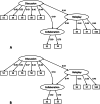Are different station formats assessing different dimensions in multiple mini-interviews? Findings from the Canadian integrated French multiple mini-interviews
- PMID: 35962381
- PMCID: PMC9375358
- DOI: 10.1186/s12909-022-03681-4
Are different station formats assessing different dimensions in multiple mini-interviews? Findings from the Canadian integrated French multiple mini-interviews
Abstract
Background: Multiple mini-interviews (MMI) are used to assess non-academic attributes for selection in medicine and other healthcare professions. It remains unclear if different MMI station formats (discussions, role-plays, collaboration) assess different dimensions.
Methods: Based on station formats of the 2018 and 2019 Integrated French MMI (IFMMI), which comprised five discussions, three role-plays and two collaboration stations, the authors performed confirmatory factor analysis (CFA) using the lavaan 0.6-5 R package and compared a one-factor solution to a three-factor solution for scores of the 2018 (n = 1438) and 2019 (n = 1440) cohorts of the IFMMI across three medical schools in Quebec, Canada.
Results: The three-factor solution was retained, with discussions, role-plays and collaboration stations all loading adequately with their scores. Furthermore, all three factors had moderate-to-high covariance (range 0.44 to 0.64). The model fit was also excellent with a Comparative fit index (CFI) of 0.983 (good if > 0.9), a Tucker Lewis index of 0.976 (good if > 0.95), a Standardized Root Mean Square Residual of 0.021 (good if < .08) and a Root Mean Square Error of 0.023 (good if < 0.08) for 2018 and similar results for 2019. In comparison, the single factor solution presented a lower fit (CFI = 0.819, TLI = 0.767, SRMR = 0.049 and RMSEA = 0.070).
Conclusions: The IFMMI assessed three dimensions that were related to stations formats, a finding that was consistent across two cohorts. This suggests that different station formats may be assessing different skills, and has implications for the choice of appropriate reliability metrics and the interpretation of scores. Further studies should try to characterize the underlying constructs associated with each station format and look for differential predictive validity according to these formats.
Keywords: Admission; Multiple Mini-Interviews; Reliability; Selection; Undergraduate Medical Education; Validity.
© 2022. The Author(s).
Conflict of interest statement
The authors declare that they have no competing interests.
Figures
References
-
- Knorr M, Hissbach CJ, Hampe W. Interviews, Multiple Mini-Interviews, and Selection Centers. In: Patterson F, Zibarras L, editors. Selection and Recruitment in the Healthcare Professions. Switzerland: Palgrave Macmillan; 2018. pp. 113–138.
-
- Kane MT. Validating the interpretations and uses of test scores. J Educ Meas. 2013;50(1):1–73. doi: 10.1111/jedm.12000. - DOI
MeSH terms
LinkOut - more resources
Full Text Sources
Miscellaneous


